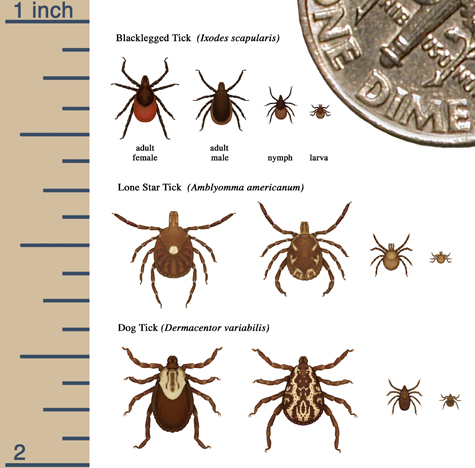Ticks Common in Connecticut
Black Legged Ticks - When ready to find a host, they quest crawling up waiting to ambush and grab hold of a host animal or person.
Lone Star Ticks - They are new to this area and increasing in population, especially in Fairfield County. Lone Star ticks are aggressive hunters and will crawl to look or chase down a host.
American Dog Tick - Only adult stage of this tick feeds on humans and pets.
image provided by the US Centers for Disease Control and Prevention
Diseases
It takes roughly 24 hours for an attached tick to transfer a disease to a host it’s embedded on.
The CDC has recognized ticks as an increasing public health threat.
There are approximately 20 diseases or illnesses related to ticks. Common ones in CT are:
Lyme Disease - Found in 38% of ticks
Anaplasma HGA/HGE - Found in 11.9% of ticks
Babesia - Found in 9.5% of ticks
40% of ticks are infected with at least one disease.
70% of Lyme disease cases are found in the summer.
General Information
Ticks quest, which is positioning themselves up on something to grab onto a host. They do not drop, jump, or fly. They live below in cool, moist areas and come up to quest until they lose moisture, then return down to re hydrate.
Adult ticks do not hibernate. On warm and sunny winter days, they will come out and look for a host. Organic tick control is not applied during winter. If a fall application spray was done by us, the adult ticks on your property at time of spraying would have been eliminated.
Tick Life Cycle
Ticks have a two year life cycle. They start off as eggs and hatch into larvae late spring and early summer. They are nymphs the following spring and become adults in the fall. Nymph ticks are the most common to infect humans with diseases.
image provided by the US Centers for Disease Control and Prevention (CDC)
Mice and Deer are the most common hosts and means of transportation
The white-footed mouse, which is the primary carrier of Lyme bacterium Borrelia burgdorferi, is a popular host of black legged ticks. They are common and easy hosts for nymph or deer ticks to feed on and contract the Lyme disease. Other common rodents ticks feed on include: chipmunks, squirrels, and birds. In the past 13 years, diseases transmitted by pathogen hosts, like mice, have tripled in number. Because of their association, ticks can be found in areas where mice live, such as stone walls, wood and leaf piles, under sheds and decks, and in ground cover like pachysandra.
Deer are the other common carriers and transporters of ticks because of their large population, grazing, and traveling habits. Studies have shown that eliminating deer from a property decreased the population of ticks. Other animals that carry ticks include foxes, groundhogs, possums, raccoons, coyotes, bobcats, and bears. All of these animals that travel are the main means in which ticks are transported distances and introduced into new areas like your property.


